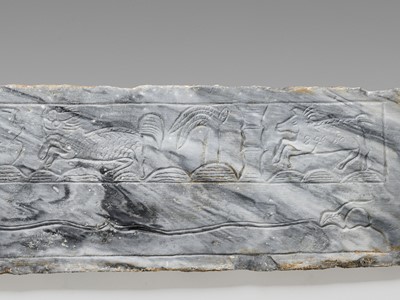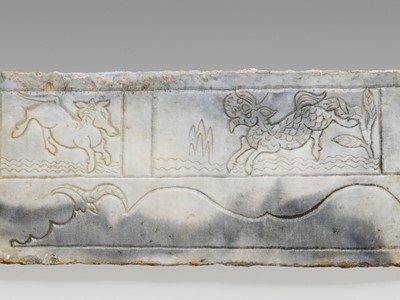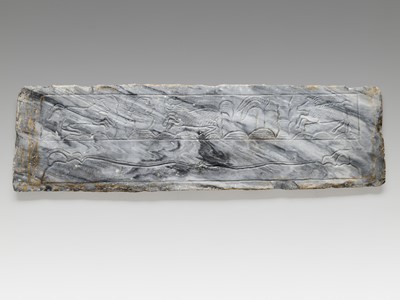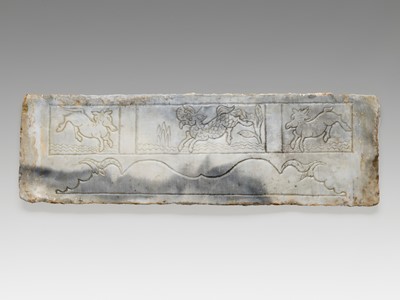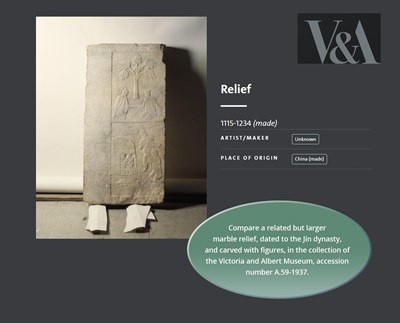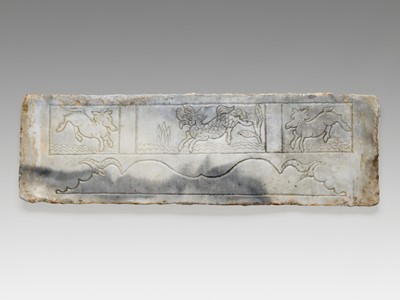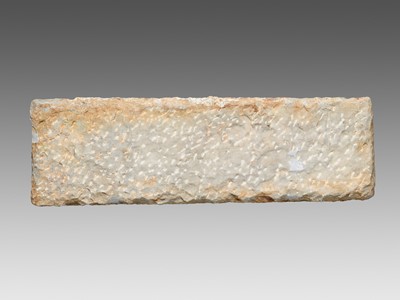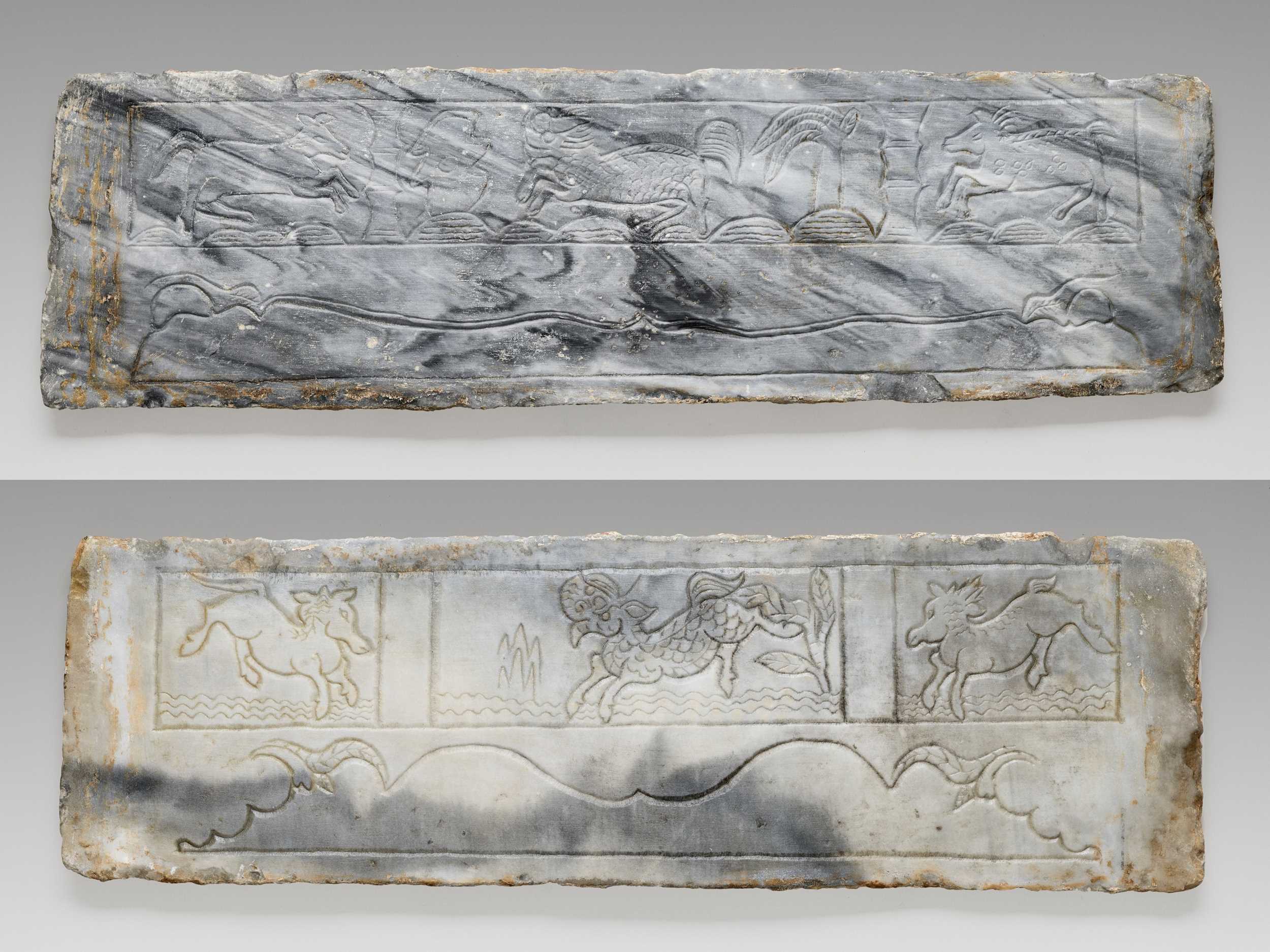27th Jan, 2022 10:00
Asian Art Discoveries
12
TWO ‘MYTHICAL BEAST’ MARBLE PANELS, FRAGMENTS OF A FUNERARY STRUCTURE, TANG TO JIN DYNASTY
Sold for €278
including Buyer's Premium
China, 618-1234. Each rectangular fragment chiseled in relief with mythical beasts striding among plants, including a chilong, two bixie, and another hybrid creature with hooves, scales, and a phoenix head, all above a gently curving, stylized leafy vine forming an outline reminiscent of a mountain range. (2)
Provenance: From an English private collection in Buckinghamshire, acquired in the 1980s and thence by descent.
Condition: Condition commensurate with age. Extensive wear, losses, signs of weathering and erosion, nicks, scratches, and encrustations.
Weight: 13.5 kg and 15.2 kg
Dimensions: Size 81.7 x 25.5 cm and 88 x 25 cm
Both with massive cast iron fittings for wall suspension, probably dating to the earlier 20th century.
The present two stone fragments were likely once segments of a funerary structure, possibly decorative panels of the walls or door to a sarcophagus. The walls of the sarcophagus of Li Shou, Prince Jing of Huai'an, now housed in the Xinjiang Uygur Autonomous Region Museum and illustrated in Angela Falco Howard, et. al, Chinese Sculpture, 2006, Beijing, fig. 2.39, feature relief carvings of beasts and stylized clouds related to the present example on its walls and around the tomb door. The tomb of Li Shou, a cousin of Tang emperor Gaozu, was erected in 631 within the emperor's Xianling necropolis.
It is also worth considering a funerary stele erected for Xiao Hongtian, illustrated in Yao Qian and Gu Bing, Nan chao ling mu shi ke, [Tomb Carvings of the Southern Dynasties], Beijing, 1981, pls. 55 and 56. Xiao was conferred as ruler of the Linchuan region in the year 502, and perished in 526. The main face of the stele comprises eight square panels with relief-carved striding mythical beasts among cloud wisps, within foliate borders.
Literature comparison: Compare a related but larger marble relief, dated to the Jin dynasty, and carved with figures, in the collection of the Victoria and Albert Museum, accession number A.59-1937.
Auction result comparison: Compare a related but more elaborate marble panel (Size 40.6 x 50.2 cm) dated to the early Tang dynasty, carved with a mythical beast striding on clouds, at Sotheby’s New York in Junkunc: Chinese Buddhist Sculpture on 12 September 2018, lot 4, sold for USD 300,000 (for a single panel).
China, 618-1234. Each rectangular fragment chiseled in relief with mythical beasts striding among plants, including a chilong, two bixie, and another hybrid creature with hooves, scales, and a phoenix head, all above a gently curving, stylized leafy vine forming an outline reminiscent of a mountain range. (2)
Provenance: From an English private collection in Buckinghamshire, acquired in the 1980s and thence by descent.
Condition: Condition commensurate with age. Extensive wear, losses, signs of weathering and erosion, nicks, scratches, and encrustations.
Weight: 13.5 kg and 15.2 kg
Dimensions: Size 81.7 x 25.5 cm and 88 x 25 cm
Both with massive cast iron fittings for wall suspension, probably dating to the earlier 20th century.
The present two stone fragments were likely once segments of a funerary structure, possibly decorative panels of the walls or door to a sarcophagus. The walls of the sarcophagus of Li Shou, Prince Jing of Huai'an, now housed in the Xinjiang Uygur Autonomous Region Museum and illustrated in Angela Falco Howard, et. al, Chinese Sculpture, 2006, Beijing, fig. 2.39, feature relief carvings of beasts and stylized clouds related to the present example on its walls and around the tomb door. The tomb of Li Shou, a cousin of Tang emperor Gaozu, was erected in 631 within the emperor's Xianling necropolis.
It is also worth considering a funerary stele erected for Xiao Hongtian, illustrated in Yao Qian and Gu Bing, Nan chao ling mu shi ke, [Tomb Carvings of the Southern Dynasties], Beijing, 1981, pls. 55 and 56. Xiao was conferred as ruler of the Linchuan region in the year 502, and perished in 526. The main face of the stele comprises eight square panels with relief-carved striding mythical beasts among cloud wisps, within foliate borders.
Literature comparison: Compare a related but larger marble relief, dated to the Jin dynasty, and carved with figures, in the collection of the Victoria and Albert Museum, accession number A.59-1937.
Auction result comparison: Compare a related but more elaborate marble panel (Size 40.6 x 50.2 cm) dated to the early Tang dynasty, carved with a mythical beast striding on clouds, at Sotheby’s New York in Junkunc: Chinese Buddhist Sculpture on 12 September 2018, lot 4, sold for USD 300,000 (for a single panel).
Zacke Live Online Bidding
Our online bidding platform makes it easier than ever to bid in our auctions! When you bid through our website, you can take advantage of our premium buyer's terms without incurring any additional online bidding surcharges.
To bid live online, you'll need to create an online account. Once your account is created and your identity is verified, you can register to bid in an auction up to 12 hours before the auction begins.
Intended Spend and Bid Limits
When you register to bid in an online auction, you will need to share your intended maximum spending budget for the auction. We will then review your intended spend and set a bid limit for you. Once you have pre-registered for a live online auction, you can see your intended spend and bid limit by going to 'Account Settings' and clicking on 'Live Bidding Registrations'.
Your bid limit will be the maximum amount you can bid during the auction. Your bid limit is for the hammer price and is not affected by the buyer’s premium and VAT. For example, if you have a bid limit of €1,000 and place two winning bids for €300 and €200, then you will only be able to bid €500 for the rest of the auction. If you try to place a bid that is higher than €500, you will not be able to do so.
Online Absentee and Telephone Bids
You can now leave absentee and telephone bids on our website!
Absentee Bidding
Once you've created an account and your identity is verified, you can leave your absentee bid directly on the lot page. We will contact you when your bids have been confirmed.
Telephone Bidding
Once you've created an account and your identity is verified, you can leave telephone bids online. We will contact you when your bids have been confirmed.
Classic Absentee and Telephone Bidding Form
You can still submit absentee and telephone bids by email or fax if you prefer. Simply fill out the Absentee Bidding/Telephone bidding form and return it to us by email at office@zacke.at or by fax at +43 (1) 532 04 52 20. You can download the PDF from our Upcoming Auctions page.
How-To Guides
How to Create Your Personal Zacke Account
How to Register to Bid on Zacke Live
How to Leave Absentee Bids Online
How to Leave Telephone Bids Online
中文版本的操作指南
创建新账号
注册Zacke Live在线直播竞拍(免平台费)
缺席投标和电话投标
Third-Party Bidding
We partner with best-in-class third-party partners to make it easy for you to bid online in the channel of your choice. Please note that if you bid with one of our third-party online partners, then there will be a live bidding surcharge on top of your final purchase price. You can find all of our fees here. Here's a full list of our third-party partners:
- 51 Bid Live
- EpaiLive
- ArtFoxLive
- Invaluable
- LiveAuctioneers
- the-saleroom
- lot-tissimo
- Drouot
Please note that we place different auctions on different platforms. For example, in general, we only place Chinese art auctions on 51 Bid Live.
Bidding in Person
You must register to bid in person and will be assigned a paddle at the auction. Please contact us at office@zacke.at or +43 (1) 532 04 52 for the latest local health and safety guidelines.

